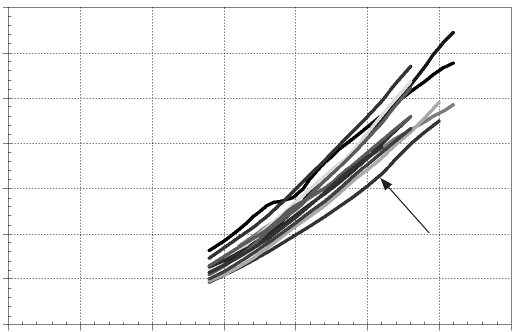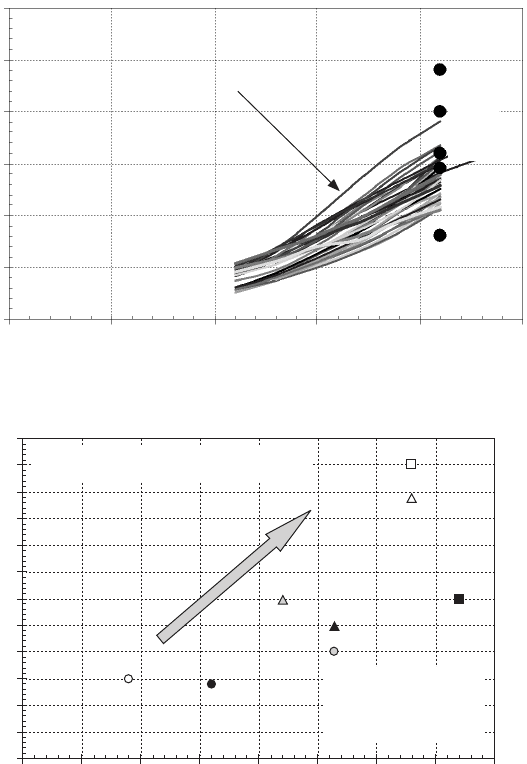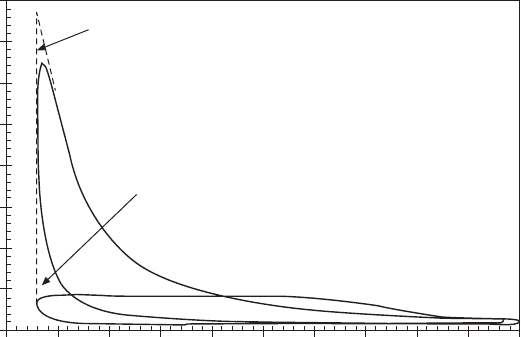Xin Q. Diesel Engine System Design
Подождите немного. Документ загружается.

408 Diesel engine system design
© Woodhead Publishing Limited, 2011
retarding products including the Jacobs Engine Brake, Jacobs Exhaust Brake
and Jacobs Driveline Brakes. It should be noted that there are many different
types of compression brakes such as the conventional compression brake,
the bleeder brake, and the exhaust-pulse-induced compression brake. Both
JVS and other companies produce many different types of engine brakes
and driveline retarders. For example, in addition to the Jacobs Engine Brake,
several compression brakes were made by other companies. These include
Mack’s Dynatard (Greathouse et al., 1971), Cummins’ C-brake, Mercedes-
Benz’s ‘Konstantdrossel’ brake, and Pacbrake’s Engine Brake.
6.1.5 Braking mechanisms of retarders
The hydrodynamic retarder converts the mechanical energy of the drive
shaft to the heat of the uid inside the retarder via a rotor-stator design. Its
retarding torque depends on the amount of uid ow and the pressure of
the viscous uid inside the retarder. The retarding torque is controlled by
adjusting the hydraulic pressure. The uid under viscous damping is cooled
by the engine coolant through the vehicle radiator or a separate cooler (in
the case of a retarder-equipped trailer).
The electromagnetic retarder uses a disc rotating in a magnetic eld to
generate the eddy current which produces the braking torque. The braking
toque is controlled by adjusting the exciting current.
Caterpillar’s retarder ‘BrakeSaver’ (Darragh, 1974) used engine oil as
a working medium churning between a rotor and a stator. It was mounted
between the engine crankshaft and the ywheel in order to utilize the
speed–torque multiplication by the transmission.
The retarding power of an engine brake consists of the contributions
from mechanical rubbing friction power, engine accessory power (such as
the fuel pump, the water pump and the oil pump), the pumping loss power
during the intake and exhaust strokes, and the indicated power during the
compression and expansion strokes.
The simplest form of engine braking is to use the engine’s motoring
power (without fueling). The motoring power is basically a second order
function of the engine speed. Downshifting the transmission gear (e.g., from
5th gear to 4th) or turning off overdrive (in an automatic transmission) may
increase the engine speed thus increase the retarding power. However, the
engine speed should not exceed its maximum allowable limit. The engine
mechanical friction here does not include the parasitic losses from certain
vehicle accessories such as the air compressor, the power steering pump,
the radiator fan, etc. The retarding power from these vehicle accessories is
a part of the vehicle’s natural retarding capability (see equation 6.1).
In the intake-throttle brake (also called ‘vacuum engine brake’), high
pumping loss or retarding power is achieved by the fact that the piston has
Diesel-Xin-06.indd 408 5/5/11 11:50:27 AM
409Engine brake performance in diesel engine system design
© Woodhead Publishing Limited, 2011
to resist the high vacuum created in the cylinder when the piston moves
down during the intake stroke. One example of the intake-throttle brake
is that the gasoline engine develops retarding power by closing the intake
throttle plate which restricts the amount of intake air. Gasoline engines
commonly have an intake throttle to regulate the air ow to match the fuel
ow in order to achieve stoichiometric combustion. Note that the non-EGR
old diesel engines did not have an intake throttle. When the intake throttle
is closed during engine braking, a gasoline engine may generate higher
pumping loss and higher retarding power than a diesel engine of the same
displacement without an intake throttle or an exhaust brake, if compared at
the same engine speed. It should be noted that gasoline engines are designed
to run at much higher engine speeds than diesel engines and hence they may
develop higher retarding power due to their higher speed.
Similar to the intake-throttle brake, in the conventional exhaust brake
with an exhaust throttle valve, high pumping loss and retarding power
are achieved by the fact that the piston has to overcome the high exhaust
manifold pressure during braking when the piston moves up in the exhaust
stroke. The maximum potential of the intake-throttle brake comes from only
1 bar maximum in engine delta P (i.e., the difference between the 1 bar
absolute pressure in the exhaust manifold and zero bar vacuum in the intake
manifold), while the potential of the exhaust brake is much higher than 1
bar in terms of engine delta P. This is the reason why the exhaust brake is
usually used instead of an intake-throttle brake in diesel engines. In fact,
the exhaust brake is the most widely used retarder to date. It is usually used
with mid-range-power diesel engines in a wide range of Class-2 through
Class-7 vehicles, for example from the light pickup trucks that haul heavy
loads (e.g., 10,000–15,000 lbs GCVW) in hilly terrain to heavy trucks and
buses.
A compression-release engine brake is a device that can convert a diesel
engine from a power-producing machine to a power-absorbing machine, for
example to a reciprocating (piston) air compressor. During engine braking,
with the fuel ow terminated, the power required to compress the air in the
cylinder comes from the kinetic or potential energy of the moving vehicle and
the turning engine crankshaft. In this case, the engine valves remain closed
during the compression stroke. If the exhaust valve also remains closed during
the expansion stroke (as in the normal valve event in ring operation), the
compressed air will return the positive power to the vehicle via the crankshaft
during the expansion stroke so that the earlier absorbed (negative) power
is cancelled out. In this situation, the only retarding power offered by the
engine is the pumping loss during the intake and exhaust strokes as well as
the mechanical friction from the moving parts. If the exhaust valve is opened
near the end of the compression stroke or in the very early portion of the
expansion stroke, the compressed air is allowed to discharge to the exhaust
Diesel-Xin-06.indd 409 5/5/11 11:50:27 AM
410 Diesel engine system design
© Woodhead Publishing Limited, 2011
manifold thus the energy stored in the compressed air is no longer retained
in the cylinder during the expansion stroke to produce positive power. As
a result, the net effect is that the engine becomes a power-absorbing air
compressor to use the kinetic or potential energy of the moving vehicle
to pump the ambient air through the engine cylinders and then discharge
the hotter air to the atmosphere. The negative power produced during the
compression and expansion strokes contributes greatly to the total retarding
power of the engine. In this operation, such an exhaust valve is called an
engine braking valve.
In fact, the braking valve can be the exhaust valve (like in the Jake
Brake) or an additional decompression valve in the cylinder head (like in
Mercedes-Benz’s Konstantdrossel engine brake and Mitsubishi’s Powertard
engine brake). There are numerous designs and inventions to realize the
optimum functions of the braking valve(s) through mechanical, hydraulic,
and electromagnetic valvetrain mechanisms.
Although some different types of retarders can be combined to use on one
vehicle, not all of them are compatible in retarding processes or mechanisms
because the operating principle of one retarder may conict with another.
For example, an exhaust brake and a compression brake should not be used
simultaneously at high engine speeds in a turbocharged engine because the
exhaust brake operation tends to reduce the turbine pressure ratio and the
turbine speed, while a compression brake relies on high turbocharger speed
in order to deliver high boost pressure to enhance the compression-release
effect. However, for naturally aspirated engines a combination of an exhaust
brake and a compression brake has proven effective (Schmitz et al., 1992,
1994). Another example is that if the cylinder charge is basically completely
blown off during the expansion stroke in a compression brake, there will be
little air to be compressed to raise the cylinder pressure during the exhaust
stroke. Therefore, the use of an exhaust brake may not be effective in
conjunction with such a compression brake. SAE J1621 (2005) and J2458
(1998) provide information on dynamometer testing and capability rating
of engine brakes and exhaust brakes.
6.1.6 Comparison between engine brakes and drivetrain
retarders
Retarder performance is measured by the following characteristics: retarder
energy conversion ratios (related to thermodynamics), heat rejection (i.e.,
heat absorbed by the retarder and transferred to the vehicle cooling system),
maximum power, retarding power ratio (the ratio of the maximum retarding
power to the maximum ring power), low-speed torque (essentially the shape
of ‘torque vs. speed’ curve), weight, power-to-weight ratio (indicating packing
space and the stress level), power density (i.e., specic power or the ratio
Diesel-Xin-06.indd 410 5/5/11 11:50:27 AM
411Engine brake performance in diesel engine system design
© Woodhead Publishing Limited, 2011
of power to engine displacement), transient response, and noise (related to
operating mechanism). Other design attributes include durability, packaging
(installability), and cost.
In general, a hydrodynamic retarder may be able to develop a retarding
power as high as double that of the engine ring rated power. However, its
heat rejection is also very high. The cooling system used to dissipate the heat
is a great design challenge. A compression brake may be able to develop
a similar amount of retarding power as the engine ring rated power. An
exhaust brake usually produces signicantly lower retarding power. With
improved braking mechanisms and stronger engine structures, more powerful
compression brakes are being developed.
High retarding torque in the mid-speed range is very important. The torque
capability of the hydraulic and electric retarders at medium to high speeds
is usually limited by the temperature of the retarder’s cooling medium. The
drivetrain retarders often deliver poor performance (low power) at low vehicle
speeds but good performance at higher vehicle speeds, while the engine
brakes may deliver high power at low vehicle speeds. Engine brakes can
achieve this by downshifting the transmission gear to run the engine at high
speeds so that they can deliver high power on a much steeper downgrade
compared to a drivetrain retarder. The low-speed torque of an engine brake
can be increased by using an exhaust brake that throttles the turbine outlet
or inlet.
The retarder power capability or retarder design limit is often translated into
an allowable road grade for downgrade performance, or a vehicle deceleration
in a fraction of the acceleration due to gravity for level-ground performance.
For instance, a typical European legal requirement for downhill braking is
that the retarder needs to maintain 30 km/hour (18.6 mph) vehicle speed on
a 7% downgrade for 6 km (3.7 miles). Customers can be more demanding
on these requirements, for example, requiring 80 km/hr speed on a 5%
downgrade. Limpert (1975) reported that the mean vehicle deceleration when
using the engine alone was approximately 0.015 g; and using the exhaust
brake increased the mean vehicle deceleration to nearly 0.03 g. A 0.05 g
(0.5 m/s
2
) deceleration was reported in the literature for braking from 80
to 60 km/hr for a 40 ton truck (Schreck et al., 1992). As a comparison, a
0.15 g deceleration (1.47 m/s
2
) is typical in many normal vehicle stops using
the service brakes (Spurlin and Trotter, 1982), as seen in typical transit buses
from normal operating speeds to low speeds (Klemen et al., 1989).
Hydrodynamic and electromagnetic retarders are usually heavy, large and
expensive. A conventional compression brake must be structurally strong/
heavy enough to support the high loading due to the in-cylinder pressure
near the TDC (top dead center) transmitted via the braking valve, while a
compression brake actuated by variable valve timing devices can be much
lighter (e.g., reduced weight by half; Hu et al., 1997b). The exhaust-pulse
Diesel-Xin-06.indd 411 5/5/11 11:50:27 AM

412 Diesel engine system design
© Woodhead Publishing Limited, 2011
compression brake can be even lighter. The exhaust brake has very low
weight (only several kilograms) and is usually less expensive than other
retarders.
Typical engines have 5–9 hp/liter power density in motoring at 2000
rpm (SAE J1489, 2000). Exhaust brakes usually have around 10–15 hp/liter
retarding power density at 2000 rpm (Fig. 6.1). Note that the retarding power
data in this chapter are all presented as positive values for convenience.
Compression brakes may have at least 30–50 hp/liter power density (Fig.
6.2). Compression brakes usually offer higher retarding power than exhaust
brakes due to more effective retarding mechanisms of the compression-release
process during the compression and expansion strokes. Figure 6.2 shows
the retarding power of 9–16 L diesel engines equipped with conventional
compression brakes. In 1994, the highest available retarding power was 343
kW (460 hp) at 2100 rpm for the 12–15 L engine market (Freiburg, 1994).
There is a growing trend in retarding power density over the years through
design improvement. Note that the ring power density is typically about
40 hp/liter at the rated speed (e.g., 1600–2300 rpm) for big bore engines.
The retarding power density is denitely short around 1600 rpm but may
become capable at 2100 rpm. As the engine rated speed is reduced, there is an
increasingly large mismatch between the required ring speed and retarding
speed. Engine system design needs to address such a mismatch. Finally, Fig.
6.3 shows there is a large variation in the engine retarding power at a xed
engine displacement due to the variation in brake design details.
The power-to-weight ratio indicates the compactness of the retarder. The
power density of the hydrodynamic retarder is in the order of 17 hp/kg
6.1 Conventional exhaust brake performance.
0 500 1000 1500 2000 2500 3000 3500
Engine speed (rpm)
Specific retarding power (hp/liter)
35
30
25
20
15
10
5
0
The range of retarding power
of various exhaust brakes
Diesel-Xin-06.indd 412 5/5/11 11:50:27 AM

413Engine brake performance in diesel engine system design
© Woodhead Publishing Limited, 2011
(e.g., Voith Turbo’s Aquatarder). The power density of the exhaust brake is
around 30 hp/kg at 2000 rpm engine speed. The power-to-weight ratio of
the conventional compression brake is around 10–11 hp/kg.
The friction brake usually has very fast transient response and high torque
at low speed. The hydrodynamic retarder has a lling time and a delay in
response, especially for a large-volume retarder. A small torus volume can
improve the response time. The electromagnetic retarder usually has very
0 500 1000 1500 2000 2500
Engine speed (rpm)
Specific retarding power (hp/liter)
60
50
40
30
20
10
0
6.3 Competitive benchmarking analysis on exhaust brake retarding
power.
5.0 5.5 6.0 6.5 7.0 7.5 8.0 8.5 9.0
Engine displacement (liter)
1 hp = 0.7457 kW
Note: The retarding
power is plotted as
positive values here.
Competitive engine exhaust brake
performance comparison at 2750 rpm
Engine braking retarding power (hp)
240
230
220
210
200
190
180
170
160
150
140
130
120
6.2 Conventional compression-release brake performance.
The range of retarding power
of various compression brakes
2000s
1990s
1980s
1970s
1960s
Diesel-Xin-06.indd 413 5/5/11 11:50:27 AM
414 Diesel engine system design
© Woodhead Publishing Limited, 2011
fast response time. The transient response sensitivity of the hydraulic system
in the conventional compression brake can be fairly rapid (Greathouse
et al., 1971). The compression brake can achieve full operating status in about
0.2 s and deactivate in less than 0.1 s, as indicated by Morse and Rife (1979).
However, turbocharger lag may affect the transient response in terms of the
intake manifold boost pressure for the compression brake in turbocharged
engines.
Drivetrain retarders and the exhaust brake are very quiet (usually no
louder than a plain engine). The conventional compression brake is noisy
due to the high-frequency exhaust pressure pulse waves caused by the sudden
compression-release process. The bleeder brake is less noisy. Engine brake
noise is discussed in more details in Section 6.4.8.
6.1.7 Retarder energy conversion ratios
In drivetrain retarders, all the mechanical power is basically converted to
frictional heat and there is a challenge to manage this heat transfer rate. There
are two methods to manage the heat: using a waste heat recovery device, or
using a cooling system to dissipate the heat to the ambient.
For engine brakes, their energy conversion needs to be analyzed based
on the rst law of thermodynamics for the engine system. It is well known
that the fuel energy basically goes into three parts in engine ring operation
based on energy balance: the brake (shaft) work, the exhaust enthalpy, and
the coolant heat. Similarly, in engine brake operation, when the fuel energy
is zero, according to the engine energy balance the mechanical brake power
(i.e., retarding power) needs to be balanced by the exhaust enthalpy rate
and the heat rejection to the coolant. In other words, because the engine is
essentially an energy conversion device (e.g., as an air compressor in either
the compression brake or the exhaust brake), the higher the retarding power
absorbed by the engine, the higher the exhaust enthalpy rate and the heat
rejection.
The energy conversion of the retarders needs to be evaluated and compared
for their effects on engine performance. The two subjects of concern are: (1)
the heat rejection and the associated difculty for the cooling system design;
(2) the exhaust gas enthalpy and its impact on aftertreatment operation (e.g.,
in regeneration) and turbocharger transient operation. It should be noted that
the exergy of the coolant heat is so low that it is usually not worth the effort
of waste heat recovery.
In order to compare different retarders, two retarder energy conversion
ratios are dened as follows. The retarder heat dissipation ratio is dened
as
Diesel-Xin-06.indd 414 5/5/11 11:50:27 AM

415Engine brake performance in diesel engine system design
© Woodhead Publishing Limited, 2011
h
rh
ea
t
hr
jr
hrjrhr
etarding
hr
j
hrjhr
firin
gm
ax
Q
Q
,
rh,rh
jr,jr
,,
firin,,firin
gm,,gm
6.8
where
Q
hr
jr
hrjrhr
etarding
jr,jr
is the unrecoverable heat dissipation to the cooling system
during the retarder operation, and
Q
hr
j
hrjhr
firin
gm
ax
,,
j,,j
firin,,firin
gm,,gm
is the maximum engine coolant
heat rejection during the ring operation.
The retarder available exhaust energy ratio is de ned as
h
r
exh
exh
reta
rd
in
g
exh
firin
gm
ax
H
Q
,
,,
firin,,firin
gm,,gm
,
6.9
where
H
exh
reta
rd
in
g
,
is the exhaust enthalpy ow rate during the retarder
operation, and
H
exh
firin
gm
ax
,,
firin,,firin
gm,,gm
is the maximum exhaust enthalpy ow rate
during the ring operation.
Obviously, a lower retarder heat dissipation ratio less than 1 and a high
retarder available exhaust energy ratio are desirable for any retarders. The
h
r,heat
of drivetrain retarders is usually close to or much greater than 1, which
imposes a signi cant design challenge for the vehicle cooling system. The
h
r,heat
of engine brakes is usually much less than 1. Only when the engine
brake’s retarding power is several times higher than the engine rated power
is its heat dissipation ratio close to 1.
The h
r,exh
of drivetrain retarders is very low because only the exhaust heat
from engine motoring contributes to the h
r,exh
. This means during a long
downgrade the exhaust temperature available for engine aftertreatment and
turbocharger operations is very low. In contrast, the h
r,exh
of engine brakes
is usually greater than or close to 1 at the full retarding power. The exhaust
ow in engine braking contains a signi cant amount of energy to keep the
aftertreatment and the turbocharger at good operating conditions.
Therefore, it is clear that engine brakes are far superior to drivetrain
retarders from a thermodynamic perspective. This is especially true if the
comparison between the retarders is examined from the second law of
thermodynamics. Drivetrain retarders convert all the mechanical energy
of the vehicle motion to frictional heat, which has a very low availability
or exergy. Engine brakes convert the mechanical energy of the vehicle to
useable exhaust energy, which has a high availability.
6.1.8 Retarding process effi ciency of compression
brakes
The research on the retarding process ef ciency of compression brakes
was started by Israel and Hu (1993) when they analyzed the performance
sensitivity of the Jacobs compression brake to the braking system compliance
Diesel-Xin-06.indd 415 5/5/11 11:50:29 AM

416 Diesel engine system design
© Woodhead Publishing Limited, 2011
at different ambient conditions. Later, Hu et al. (1997a) applied retarding
process efciency to the study of a VVA compression brake to try to quantify
its performance benet and compare it with the conventional compression
brake. They pointed out that the maximum retarding power available comes
from an isentropic compression followed by an instantaneous sudden release
of the compressed cylinder charge at the TDC. In a real system, inevitable
losses are caused by all the factors contributing to the insufcient compression
and the non-instantaneous release of the cylinder charge (Fig. 6.4). Some
examples are as follows:
∑ There are heat losses during the compression stroke.
∑ There is a leakage or insufcient compression near the end of the
compression process caused by the opening of the braking valve. The
braking valve needs to be opened before the TDC because it cannot
open instantaneously with a sufciently large ow area right at the TDC.
Note that there is a restriction of valve-to-piston clearance at the TDC.
Moreover, the braking valve opening timing is selected to try to limit
the maximum cylinder pressure and the associated gas loading acting
on the braking assembly from a structural durability point of view.
∑ The residue cylinder pressure during the expansion stroke caused by
incomplete blow-down result in some positive power. This is caused
mainly by the restriction of the supersonic ow across the braking
valve.
∑ The hydraulic compliance of the engine brake system may lower the
braking valve lift and increase the residue pressure in the expansion
stroke.
Loss due to early blow-down
Loss due to incomplete blow-down and
residue pressure producing positive power
0 0.1 0.2 0.3 0.4 0.5 0.6 0.7 0.8 0.9 1
Instantaneous in-cylinder volume
Cylinder pressure (bar, absolute)
80
70
60
50
40
30
20
10
0
6.4 Illustration of retarding process efficiency of compression brake.
Diesel-Xin-06.indd 416 5/5/11 11:50:29 AM

417Engine brake performance in diesel engine system design
© Woodhead Publishing Limited, 2011
Israel and Hu (1993) de ned the retarding process ef ciency of compression
brakes as the ratio of the actual retarding power to the isentropic retarding
power during the compression and expansion strokes, given by
h
rC
R
rCRrC
ra
ctual
ri
se
ntr
opi
c
W
ra
W
ra
W
ri
W
ri
,
rC,rC
,
ra,ra
,
ri,ri
6.10
The pumping loss and mechanical friction are excluded in the ef ciency
de nition of equation 6.10. In order to calculate the retarding process
ef ciency, the actual retarding power can be computed based on the cylinder
p–V diagram or can be measured in the compression and expansion strokes.
Israel and Hu (1993) proposed that the isentropic retarding power can be
computed by the following equation during the compression stroke, assuming
the power is zero during the expansion stroke:
W
c
T
p
p
ri
W
ri
W
se
ntr
opi
c
pC
cC
c
,
ri,ri
=
(
(
pC
(
pC
)
pC
(
pC,pC
(
pC
kh
cC
kh
cC
(
kh
(
)
kh
)
k
W
-
-
Ê
Ë
Ê
Ë
Ê
Ê
Á
Ê
Ë
Á
Ë
Ê
Ë
Ê
Á
Ê
Ë
Ê
ˆ
¯
ˆ
¯
ˆ
1
1
T
1
T
kh
1
kh
2
1
)1 )
1
ˆ
˜
ˆ
˜
ˆ
˜
ˆ
¯
˜
¯
˜
¯
˜
¯
ˆ
¯
ˆ
˜
ˆ
¯
ˆ
˜
ˆ
¯
ˆ
˜
ˆ
¯
ˆ
-
È
Î
Í
È
Í
È
Í
Î
Í
Î
Í
Í
Í
˘
˚
˙
˘
˙
˘
˙
˚
˙
˚
Ï
Ì
kh
Ì
kh
Ô
Ï
Ô
Ï
Ì
Ô
Ì
Ó
kh
Ó
kh
cC
kh
cC
Ó
cC
kh
cC
kh
Ô
kh
cC
kh
cC
Ô
cC
kh
cC
kh
Ì
kh
Ô
kh
Ì
kh
Ó
Ô
Ó
kh
Ó
kh
Ô
kh
Ó
kh
cC
kh
cC
Ó
cC
kh
cC
Ô
cC
kh
cC
Ó
cC
kh
cC
¸
˝
Ô
¸
Ô
¸
˝
Ô
˝
˛
Ô
˝
Ô
˝
˛
Ô
˛
-
k
k
c
c
1
11
˙
11
˙
+
11 +11
˙
11
˙
+
˙
11
˙
˙
11
˙
+
˙
11
˙
˙
˙
˙
11
˙
˙
˙
+
˙
˙
˙
11
˙
˙
˙
6.11
where p
1
is the compressor inlet pressure, p
2
is the compressor outlet pressure,
T
1
is the compressor inlet temperature, h
C
is the compressor ef ciency,
and W is the engine compression ratio. It should be noted that equation
6.11 is only valid for a simpli ed closed thermodynamic system under the
assumption that all the engine valves are closed from the BDC to TDC for
an isentropic compression. In reality, the intake valve actually closes about
40∞ crank angle after the BDC. Moreover, equation 6.11 is not applicable
for the case of having braking gas recirculation (BGR, to be detailed later)
where the exhaust valve is open during the compression stroke and the initial
state of the gas at the beginning of the compression is complicated by the
BGR gas mixing.
The above retarding process ef ciency for the compression brakes is a
measure of the perfection of the thermodynamic process. The de nition
provides a fair basis to compare the performance of a given compression
brake at different design or operating conditions (e.g., engine speeds, ambient
conditions), or to compare the effectiveness of different types of compression
brakes. In order to increase the actual retarding power, either the retarding
process ef ciency or the ideal isentropic maximum available power needs
to be increased. In order to increase the isentropic power, intake manifold
pressure or engine compression ratio needs to be increased. This will result
in an increase in peak cylinder pressure, which in fact is limited by the
maximum gas loading that can be sustained by the braking assembly.
It is dif cult to de ne a similar ef ciency for the retarding process in
the pumping loss strokes. Recall from Chapter 4 that the pumping loss is
Diesel-Xin-06.indd 417 5/5/11 11:50:29 AM
